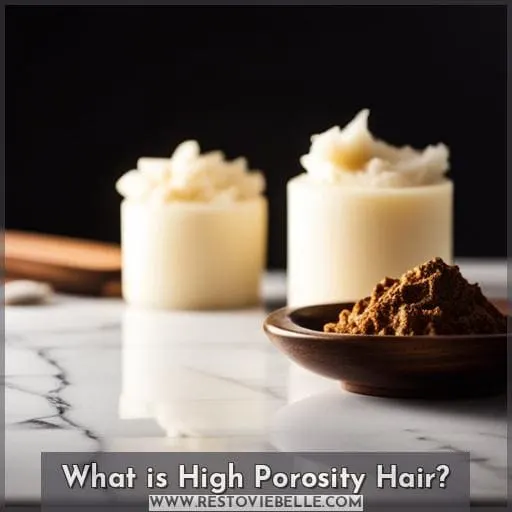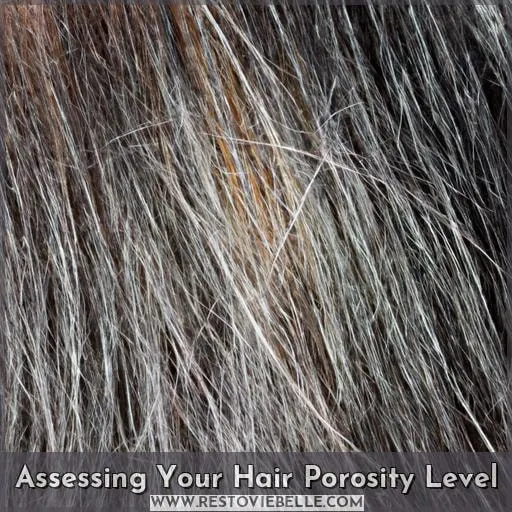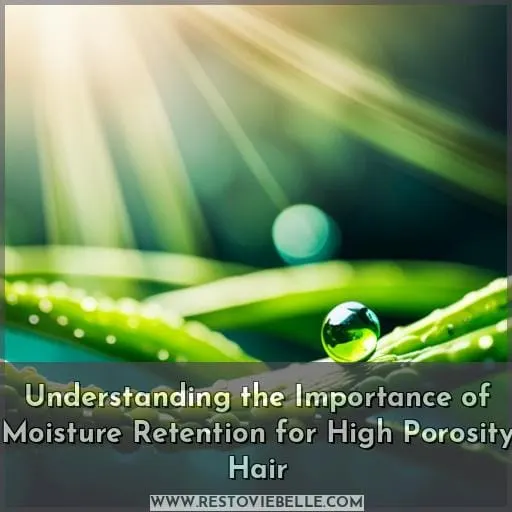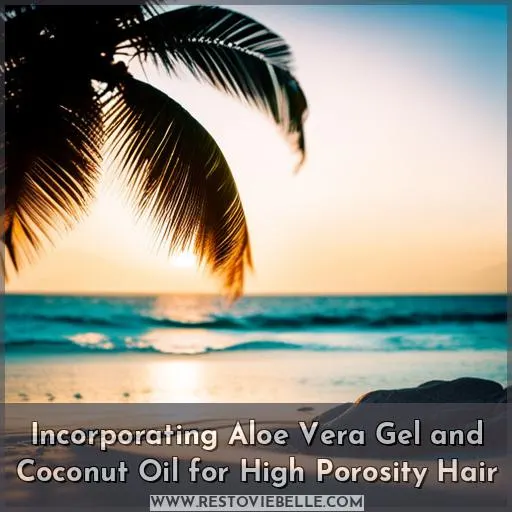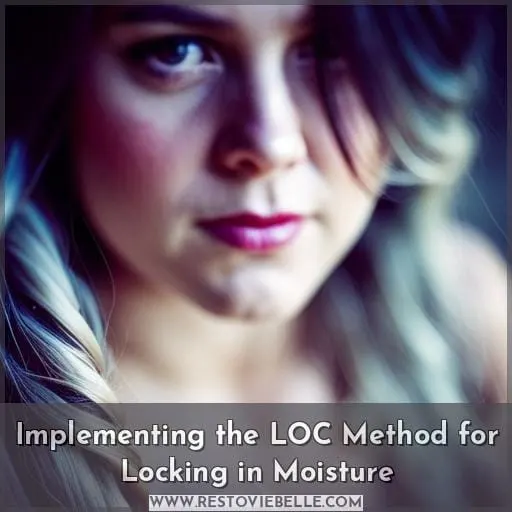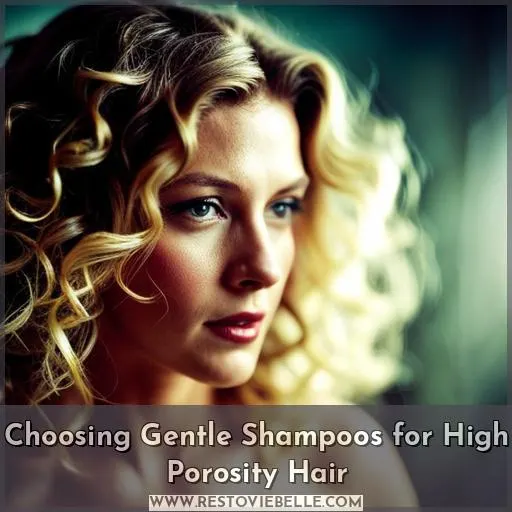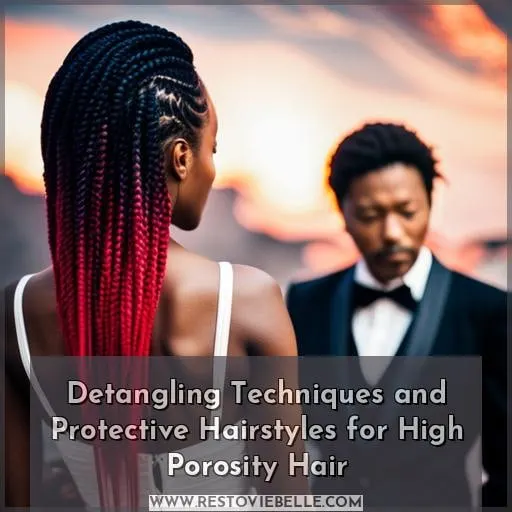This site is supported by our readers. We may earn a commission, at no cost to you, if you purchase through links.
 I know what you are thinking – why should I care about hair porosity? Sure, having shiny, frizz-free hair sounds nice, but is it really that important? Here’s the deal: understanding your hair’s porosity and adjusting your routine accordingly is crucial for keeping your hair healthy.
I know what you are thinking – why should I care about hair porosity? Sure, having shiny, frizz-free hair sounds nice, but is it really that important? Here’s the deal: understanding your hair’s porosity and adjusting your routine accordingly is crucial for keeping your hair healthy.
When you have high porosity hair, it desperately needs moisture to avoid dryness and breakage. The good news is, with some targeted tips, you can learn how to properly care for your high porosity hair.
Stick with me and I’ll walk you through everything you need to know to help your high porosity hair grow long and strong.
Table Of Contents
- Key Takeaways
- What is High Porosity Hair?
- Assessing Your Hair Porosity Level
- Understanding the Importance of Moisture Retention for High Porosity Hair
- Tips for Promoting Hair Growth in High Porosity Hair
- Incorporating Aloe Vera Gel and Coconut Oil for High Porosity Hair
- Implementing the LOC Method for Locking in Moisture
- Utilizing Protein Treatments to Strengthen High Porosity Hair
- Applying Apple Cider Vinegar for PH Balance and Shine
- Choosing Gentle Shampoos for High Porosity Hair
- Detangling Techniques and Protective Hairstyles for High Porosity Hair
- Conclusion
Key Takeaways
- Moisture retention is crucial – use hydrating treatments like deep conditioning and the LOC method.
- Strengthen hair with protein treatments.
- Maintain pH balance with apple cider vinegar.
- Use gentle, moisturizing products like aloe vera gel and coconut oil.
What is High Porosity Hair?
High porosity hair is caused by over manipulation, chemicals, heat, and over-processing, leading it to feel dry, brittle, and prone to tangling. This type of hair is characterized by the cuticle layer being raised, allowing moisture to enter easily but also escape quickly.
As a result, those with high porosity hair often struggle with keeping their hair properly hydrated and retaining moisture. To care for high porosity hair, focus on using moisturizing and sealing products that attract and seal in moisture.
Avoid ingredients that can be drying or damaging. Deep condition regularly and use protective styles to prevent further manipulation and damage. With the right regimen, high porosity hair can regain its health, moisture and shine.
Causes of High Porosity Hair
You’re constantly exposing your hair to harsh chemicals and heat styling, which causes excessive damage, leaving it unable to retain moisture.
- Too frequent use of chemical treatments like hair dye, perms, relaxers, and bleaching.
- Overuse of heat styling tools like blow dryers, flat irons, and curling irons without heat protection.
- Insufficient conditioning and washing too frequently that strips hair’s natural oils.
- Environmental factors like sun, salt water, hard water, and pollution that damage the hair cuticle.
Implementing a gentler hair care routine with less manipulation and chemicals, while using hydrating products, will help repair and prevent further damage.
Characteristics of High Porosity Hair
With that high porosity hair, aren’t you just lucky to be so blessed? Your hair soaks up moisture like a sponge but struggles to keep it in. It can feel parched and brittle despite looking hydrated. Frizz, tangles, and breakage quickly arise without proper care.
But with some know-how, you can get your hair back to a balanced state. Careful product selection, gentle handling, and strategic styling will keep your strands smooth and resilient. Don’t dread the ‘fro, learn to work with your hair’s nature. With a little TLC, your hair will thrive and shine through any porosity problems.
Assessing Your Hair Porosity Level
Determining your hair’s porosity level is important for choosing the right hair care regimen. You will need to assess whether you have low, normal, or high hair porosity in order to properly care for your strands.
Low Hair Porosity
Listen up: your hair struggles to retain moisture properly. Low porosity hair deflects moisture and humidity, refusing water absorption. Opt for moisturizing products and gentle heat styling to open the cuticle, permitting deep conditioning.
Avoid heavy oils and proteins that further seal the cuticle. Focus on hydrating ingredients like aloe vera and glycerin to provide much-needed moisture. Finger detangling prevents breakage. With care, low porosity hair will drink up hydration.
Normal Hair Porosity
Though the hair journey seems long, nourishing normal porosity tresses with patience and care keeps split ends at bay.
- Maintain moisture balance with coconut oil and aloe vera gel.
- Loc method seals in hydration.
- Avoid overwashing and heat styling.
- Use heat protectant and gentle detangling.
High Hair Porosity
Realize your hair’s every need for care and attentive nourishment. Aloe vera benefits hair hydration and moisture retention. Use protective hairstyles, protein treatments, and aloe vera to nourish your high porosity hair.
Implement a hair care routine focused on hydration and reducing breakage for healthy high porosity hair.
Understanding the Importance of Moisture Retention for High Porosity Hair
You must maintain proper moisture levels when caring for your high porosity hair. The key is finding techniques and products that boost hydration and moisture retention. This prevents dryness and damage that leads to breakage. Focus on sealing in moisture after washing with heavy creams, natural oils, or hydrating ingredients like apple cider vinegar.
These nourish hair fibers, smooth the cuticle, and prevent moisture from escaping.
Regular deep conditioning gives an intensive boost of hydration. Low-tension hairstyles and silk pillowcases also reduce friction and moisture loss overnight. Overall, retaining moisture is essential for strengthening high porosity hair. The right moisturizing regimen will dramatically improve softness, elasticity, and minimize breakage over time.
Your hair’s health depends on keeping those hydration levels balanced. The right moisturizing regimen will dramatically improve softness, elasticity, and minimize breakage over time.
Tips for Promoting Hair Growth in High Porosity Hair
High porosity hair often suffers from dryness and breakage, which slows growth. A balanced diet, deep conditioning treatments, protective styling methods, and properly hydrating your hair can all help promote healthy growth for high porosity hair.
Varying your hair care routine and using moisturizing products formulated for high porosity hair will help nourish strands and support growth. Reducing heat styling, wearing protective styles, and minimizing damage through gentle detangling and handling can also minimize breakage.
With a little extra TLC and the right techniques, you can help your high porosity hair grow long and strong.
Diet and Nutrition
- Eat nutritious, balanced meals.
- Stay hydrated by drinking plenty of water.
- Take a daily multivitamin containing biotin.
Focus on consuming adequate protein, iron, zinc and vitamin C daily, as they provide essential nutrients for strong hair growth.
Deep Conditioning and Hydration
Course deep conditioning your hair with restorative formulas will hydrate and repair it. Weekly deep conditioning seals in moisture, strengthens strands, and prevents breakage. Alternate protein and moisture masks for balance. Leave on for at least 30 minutes with heat for penetration.
Hydrate hair with leave-ins, creams, or mists too. Limit harsh shampoos, heat styling.
Protective Styling
Keep kinky knots kind with protective styles that shield strands. Braids benefit by reducing manipulation and friction, which leads to less breakage. Use silkier scrunchies, not snaggy elastic bands. Before blowouts, prep with heat shields.
Finger detangle gently in sections after conditioning. Install a shower filter to block mineral buildup.
Avoiding Heat Damage
When it comes to avoiding heat damage, opt for low-tension hairstyles and be sure to use a heat protectant before styling. Heat-free styling such as braids, buns, or twists keeps hair healthy and hydrated.
Moisture-sealing techniques like applying oils help reduce frizziness from the sun’s rays. Silk accessories like scarves can also protect against breakage when worn overnight.
Incorporating Aloe Vera Gel and Coconut Oil for High Porosity Hair
You’d be surprised to know that over 40% of women have high porosity hair. Smooth some aloe vera gel on wet hair after washing to seal in moisture before applying coconut oil to nourish and strengthen your strands.
With its hydrating and antimicrobial properties, aloe vera gel benefits high porosity hair by promoting moisture retention so hair doesn’t dry out. Its nourishing enzymes hydrate and restore hair elasticity while creating a protective barrier.
Follow up with coconut oil, rich in fatty acids and antioxidants, to deeply condition damaged cuticles, reducing protein loss and breakage. The medium-chain fatty acids penetrate inside the hair shaft to reinforce and mend porous spots.
Using these natural ingredients regularly will have you flaunting noticeably shinier, softer tresses in no time.
Implementing the LOC Method for Locking in Moisture
Now that you know how to use aloe vera gel and coconut oil for high porosity hair, let’s explore another popular method to lock in moisture – the LOC method. This technique seals in hydration by layering products in a specific order. Start with a liquid moisturizer or leave-in conditioner as your base.
Focus on hydrating formulas without silicones or waxes so moisture can penetrate.
Next comes an oil, like coconut or olive oil, to seal the liquid. Finally, use a creamy product like a curl cream or butter to further lock everything in. Perform this routine after washing at night so your hair can fully absorb the moisture overnight.
Properly implementing the LOC method with the right hydrating products is key for growing out your high porosity hair by reducing frizz and breakage.
Utilizing Protein Treatments to Strengthen High Porosity Hair
Deep condition your strands weekly with protein treatments for strengthening high porosity hair and reducing breakage.
- Keratin treatments penetrate the hair cuticle to fill gaps and reinforce strands.
- Rice water repairs damage with amino acids for stronger, healthier hair.
- Egg masks boost shine and elasticity to prevent snapping and ripping.
- Shea butter smooths and seals in moisture while adding strength.
- Coconut oil penetrates strands to nourish, protect, and improve elasticity.
Protein is essential for fortifying and revitalizing high porosity hair. However, it’s crucial to balance protein with moisture to avoid brittle, dry hair. Stick to a weekly deep conditioning routine, focusing on hydrating masks in between protein treatments.
Your stands will be reinforced from the inside out, becoming resistant to damage and breakage.
Applying Apple Cider Vinegar for PH Balance and Shine
Controlling your hair’s pH balance helps restore shine, so rinse with diluted apple cider vinegar after shampooing. The acidic nature of apple cider vinegar will help seal the hair cuticles for added shine and less frizz.
| Benefits | How to Use |
|---|---|
| Restores pH balance | Mix 1 part ACV to 2 parts water |
| Closes cuticles | Pour over hair after shampooing |
| Increases shine | Let sit for a few minutes |
| Reduces frizz | Rinse out thoroughly |
Balancing your hair’s pH and sealing the cuticle gives it a glossy, frizz-free finish. For best results, use raw, unfiltered apple cider vinegar. With this simple, natural rinse, your hair will look salon-fresh between washes.
Choosing Gentle Shampoos for High Porosity Hair
When choosing shampoos for high porosity hair, opt for gentle formulas free of harsh detergents that can cause further damage. Look for nourishing cleansers like babassu or shea butter, and consider products like SheaMoisture High Porosity Shampoo that are formulated for fragile strands.
Gentle, moisturizing shampoos without sulfates or parabens can help strengthen and hydrate porous locks without causing additional harm. Seek out options with natural oils and butters to nourish weak areas and avoid ingredients that could lead to more breakage.
Benefits of gentle shampoos
It’s wise to lather up with sulfate-free shampoos, as their gentle cleansers won’t strip your mane’s natural oils. Opt for formulas with hydrating ingredients like aloe and coconut oils that cleanse yet nourish your parched strands.
Choosing the right shampoo ensures a healthy scalp and locks in moisture without disturbing your hair’s delicate pH balance.
Ingredients to look for
You’ll see hydrating oils like argan and coconut on those labels. Look for nourishing ingredients like aloe vera, honey, and shea butter that provide moisture without weighing hair down. Natural humectants like glycerin draw moisture into each strand. Plant extracts like marshmallow and sea kelp contain vitamins and minerals to strengthen hair.
Avoid sulfates and harsh detergents in shampoos that can strip hair and exacerbate dryness. Opt for gentle, hydrating formulas with botanical ingredients to nourish hair, seal in moisture, reduce frizz, and prevent breakage.
Best shampoo recommendations
SheaMoisture’s Jamaican Black Castor Oil Strengthen & Restore Shampoo adds elasticity while soothing the scalp. Carol’s Daughter Monoi Repairing Shampoo revives dull strands with monoi oil. DevaCurl’s Low-Poo Delight Weightless Waves Shampoo gently cleanses without stripping hair of moisture.
Look for formulas rich in nourishing oils that won’t overstrip already porous hair fibers. Research brands committed to using natural, effective ingredients tailored to dry hair needs. Adding the right shampoo can help restore strength and shine to brittle, high porosity locks.
Detangling Techniques and Protective Hairstyles for High Porosity Hair
You can avoid damage from detangling by using the right techniques and accessories. Start by applying a moisture sealing mist and separating your hair into sections. Use wide-tooth combs and your fingers to gently detangle from ends to roots. Avoid dragging aggressive brushes through your delicate strands.
Protective styles like braids and twists using silk scrunchies instead of tight elastic bands are great.
Some options to consider:
- Rice water rinses – Contain proteins and vitamins that strengthen and improve elasticity. Reduce breakage.
- Large braids or twists – Allow you to moisturize hair while reducing manipulation.
- Loose updos – Keep hair off your shoulders and avoids friction.
Gentle, regular detangling and low-tension protective styles will lead to healthier, stronger hair over time.
Conclusion
Nurturing high porosity hair requires special care and techniques to promote healthy growth. An estimated 65% of Black women have high porosity hair. By using deep conditioning treatments, protective styles, and natural oils like aloe vera and coconut oil, you’ll boost moisture retention in your porous strands.
This strengthens hair over time and reduces breakage, enabling length to accumulate.
Implementing the LOC method seals in hydration while gentle handling and protein treatments reinforce weak areas prone to damage in high porosity hair. With a consistent hair care regimen tailored to your porosity level, you’ll retain length and achieve your hair growth goals.

